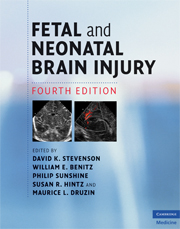Book contents
- Frontmatter
- Contents
- List of contributors
- Foreword
- Preface
- Section 1 Epidemiology, pathophysiology, and pathogenesis of fetal and neonatal brain injury
- Section 2 Pregnancy, labor, and delivery complications causing brain injury
- 5 Prematurity and complications of labor and delivery
- 6 Risks and complications of multiple gestations
- 7 Intrauterine growth restriction
- 8 Maternal diseases that affect fetal development
- 9 Obstetrical conditions and practices that affect the fetus and newborn
- 10 Fetal and neonatal injury as a consequence of maternal substance abuse
- 11 Hypertensive disorders of pregnancy
- 12 Complications of labor and delivery
- 13 Fetal response to asphyxia
- 14 Antepartum evaluation of fetal well-being
- 15 Intrapartum evaluation of the fetus
- Section 3 Diagnosis of the infant with brain injury
- Section 4 Specific conditions associated with fetal and neonatal brain injury
- Section 5 Management of the depressed or neurologically dysfunctional neonate
- Section 6 Assessing outcome of the brain-injured infant
- Index
- Plate section
- References
9 - Obstetrical conditions and practices that affect the fetus and newborn
from Section 2 - Pregnancy, labor, and delivery complications causing brain injury
Published online by Cambridge University Press: 12 January 2010
- Frontmatter
- Contents
- List of contributors
- Foreword
- Preface
- Section 1 Epidemiology, pathophysiology, and pathogenesis of fetal and neonatal brain injury
- Section 2 Pregnancy, labor, and delivery complications causing brain injury
- 5 Prematurity and complications of labor and delivery
- 6 Risks and complications of multiple gestations
- 7 Intrauterine growth restriction
- 8 Maternal diseases that affect fetal development
- 9 Obstetrical conditions and practices that affect the fetus and newborn
- 10 Fetal and neonatal injury as a consequence of maternal substance abuse
- 11 Hypertensive disorders of pregnancy
- 12 Complications of labor and delivery
- 13 Fetal response to asphyxia
- 14 Antepartum evaluation of fetal well-being
- 15 Intrapartum evaluation of the fetus
- Section 3 Diagnosis of the infant with brain injury
- Section 4 Specific conditions associated with fetal and neonatal brain injury
- Section 5 Management of the depressed or neurologically dysfunctional neonate
- Section 6 Assessing outcome of the brain-injured infant
- Index
- Plate section
- References
Summary
Placenta previa
The implantation of the placenta over the cervical os or very near to it is known as placenta previa. It may be total, when the internal cervical os is completely covered by placenta; partial, when the internal os is partially covered by placenta; marginal, when the edge of the placenta is at the margin of the internal os; or low-lying, when the placental edge does not reach the internal os but is in close proximity to it.
Incidence
The incidence of placenta previa is about 3–6/1000 singleton pregnancies. In an unscarred uterus it has been reported to be 0.26%, and it increases almost linearly with the number of prior cesarean deliveries, up to 10% in patients with four or more prior cesareans. In a study from the state of New Jersey evaluating almost 550,000 deliveries where the diagnosis of placenta previa was confirmed only in pregnancies delivered by cesarean, the incidence was 5/1000 births.
Etiology and risk factors
The likelihood of placenta previa rises with multiparity, advancing maternal age, especially in women older than 35 years old, and a history of prior cesarean deliveries. Smoking during pregnancy can double the risk of this condition, and women of Asian origin have been reported to have an increased risk of a delivery complicated by placenta previa compared to Caucasian women.
- Type
- Chapter
- Information
- Fetal and Neonatal Brain Injury , pp. 103 - 109Publisher: Cambridge University PressPrint publication year: 2009

